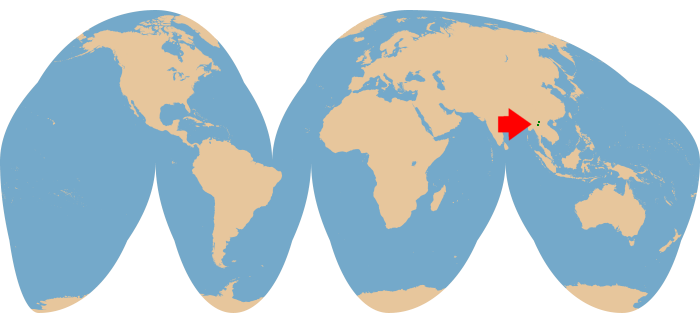Kingdom: |
Animalia Chordata Mammalia Artiodactyla Ruminantia Tragulidae Tragulus |
Common name:
Scientific name:
Other names: |
Northern chevrotain
Tragulus williamsoni
Northern mouse-deer, Yunnan chevrotain, Williamson's chevrotain |
Physical Characteristics
- Head and body length: 52.5 cm, based on a single skin from an adult female
This diminutive ungulate has the typical wedge-shaped body form of chevrotains with the rump being the highest point. From the original description, published in 1916 based on a single specimen, the overall color is finely-speckled medium brown, with the back and rump tawny. The undersides are white, with a faint buff-colored line down the centre of the chest and abdomen. The front legs are more orange in color than the body, while the hind limbs are slightly darker. The tail is brown above and white on its underside. The sides of the neck are brighter than the body, while the nape of the neck has an indistinct stripe of slightly darker hair. The head (especially the forehead) is dark. On the throat, a white patch (continuous with the pale underjaw) is split into three sections by two narrow bands (6-8 mm wide) of brown fur.
- Similar species
- Externally, the northern chevrotain is very similar to the lesser Malayan chevrotain (Tragulus kanchil), although it is significantly larger in overall size and is more tawny overall.
Reproduction and Development
Nothing known. Presumably similar to other members of the genus Tragulus.
Ecology and Behavior
- Family group: Solitary.
- Diet: Suggested to be fruits and young leaves.
- Main Predators: Unknown, but likely many medium-sized carnivores. Asian golden cat, leopard cat, dhole, and yellow-throated marten are all found in the same area as the northern chevrotain.
- Diet: Suggested to be fruits and young leaves.
Habitat and Distribution

Conservation Status
- IUCN Red List:
Data Deficient (2015).
- CITES Listing: Not listed (2017).
- Threats: Unmeasured; hunting pressure and habitat loss are likely.
- CITES Listing: Not listed (2017).
The conservation status of this species is not understood, primarily due to taxonomic uncertainties and lack of distribution data. More research is needed for a proper assessment.
